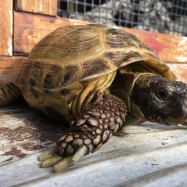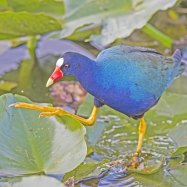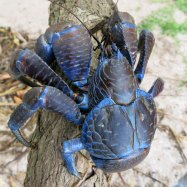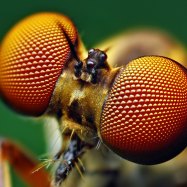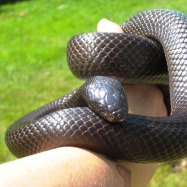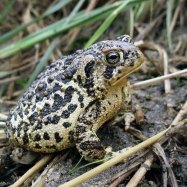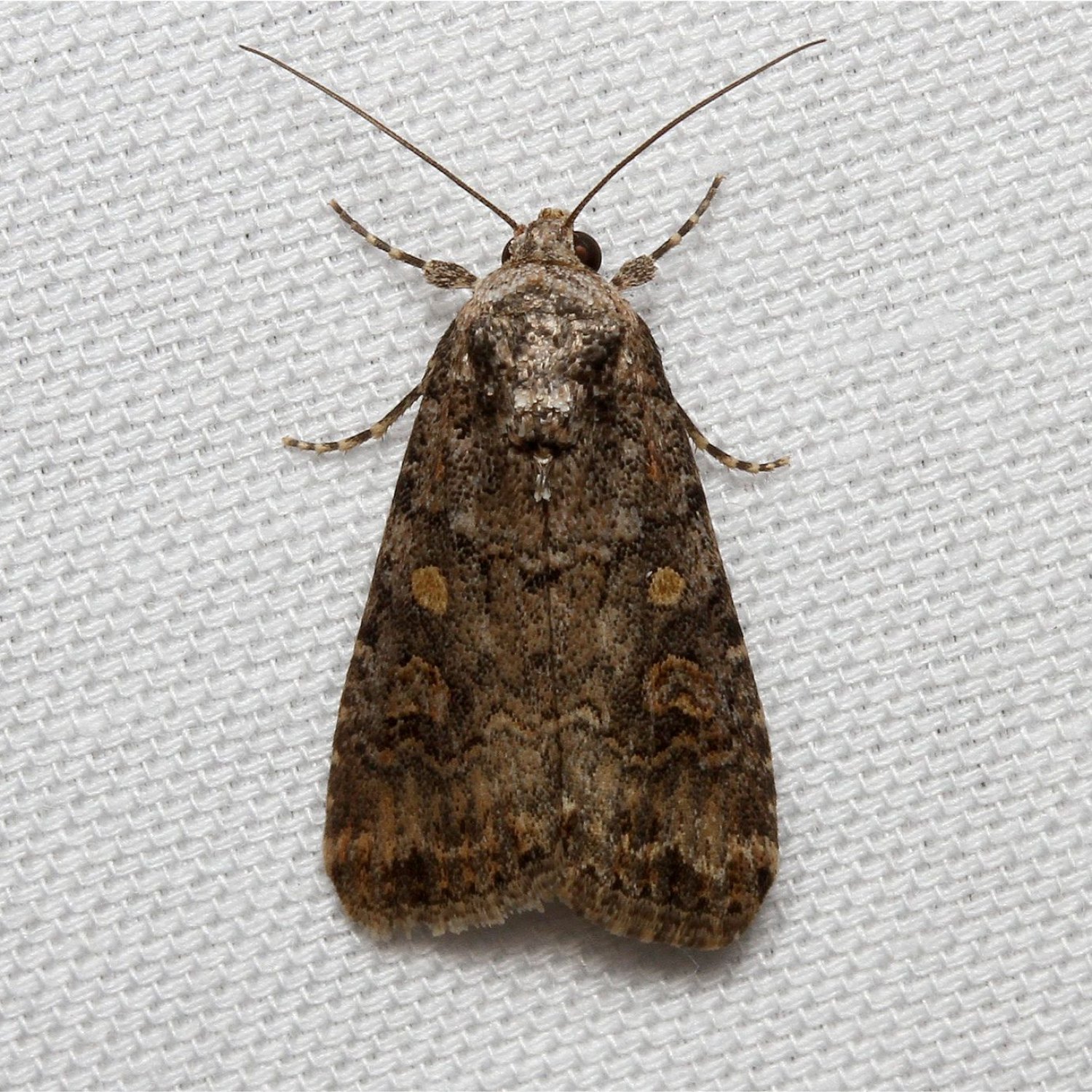
Armyworm
1.5 to 2 inches
Learn all about the armyworm, a type of moth found worldwide that belongs to the Noctuidae family. These cylindrical-shaped creatures measure 1.5 to 2 inches in length and can cause serious damage to crops. Educate yourself on how to identify and control this pest to protect your plants. #Armyworm #PestControl #Noctuidae #Crops
Animal Details Summary:
Common Name: Armyworm
Kingdom: Animalia
Habitat: Grasslands, agricultural fields, and meadows
The Fascinating Armyworm: An Insect with a Unique Way of Living
When we think of army, the image of brave soldiers in uniform comes to our mind. But what about an insect that is called an armyworm? Intriguing, isn't it? But don't be fooled by its name, this insect is not a warrior, but it does have a unique and fascinating way of living.The Armyworm, scientifically known as Mythimna unipuncta, is a type of moth belonging to the Kingdom Animalia, Phylum Arthropoda, and Class Insecta. They can be found in the Order Lepidoptera and the Family Noctuidae Armyworm. With its distinct features and interesting behavior, let's take a closer look at this intriguing insect.
Appearance and Habitat
The Armyworm gets its name from its behavior of moving in large numbers and consuming everything in their path, just like an army. But what is more interesting about this insect is its appearance. They are light brown or green in color with dark stripes. Their body is cylindrical, and they can grow up to 1.5 to 2 inches in length.These insects are found in a variety of habitats, including grasslands, agricultural fields, and meadows. They have a widespread geographical distribution, with their presence in North and South America and several other parts of the world. It is difficult to pinpoint a specific country of origin for these creatures as they have been found all over the world Argentinosaurus.
Feeding Behavior
Like most insects, the Armyworm is also an herbivore. But what sets it apart is its feeding method. These insects are known for their immense appetite and voracious feeding behavior. They feed on a variety of crops, including corn, wheat, soybeans, and rice, making them quite a nuisance for farmers.However, their feeding behavior has an interesting twist. Armyworms do not feed individually, but instead, they move in large groups, devouring everything in their path. This behavior is called "mass migration," and it is one of the most intriguing aspects of this insect's life.
Mass Migration
The Armyworm has a unique way of moving in large numbers from one place to another, hence the name "mass migration." But why do they migrate in such massive numbers? There are a few theories to explain this behavior.One theory suggests that the larvae, the juvenile stage of the Armyworm, have a limited food supply in one area. So, they move in large numbers to find new feeding grounds. Another theory proposes that these insects are escaping environmental conditions like overpopulation or drought.
Whatever the reason may be, witnessing a mass migration of Armyworms is a sight to behold. Millions of these insects moving in unison, eating and trampling everything in their path, can be a devastating sight for farmers, but for us viewers, it's a fascinating natural phenomenon.
Adaptability and Life Cycle
The Armyworm's mass migration behavior is linked to its remarkable adaptability to different environments. These insects are well-equipped to withstand different weather conditions, making them a hardy species. They can survive cold winters and hot summers, making them a year-round threat for crops.The life cycle of an Armyworm starts as eggs that are laid on the leaves of plants. The larvae hatch from these eggs and start feeding on the leaves, growing bigger in size each day. After several molting stages, they enter the pupal stage, where they metamorphose into moths. The adult moths then mate, and the females lay eggs, continuing the cycle.
The Armyworm Predicament
While the Armyworm may seem like a nuisance for farmers, their mass migration behavior has a significant impact on the environment. These insects consume large amounts of vegetation in a short period, causing considerable damage to crops and vegetation in general. This can lead to significant economic losses for farmers, affecting their livelihood.But the Armyworm's predicament is not only limited to destruction of crops. These insects have also been linked to causing diseases in plants, making them an even bigger threat. The use of chemical pesticides is not always an effective solution, as these insects can develop resistance to them over time.
Natural Solutions
With the potential harm that Armyworms can cause, it becomes essential to find natural solutions to control their population. And nature has provided just that. Birds and predators like beetles and spiders are known to feed on these insects, keeping their population in check.Another interesting natural phenomenon is the parasitic wasp. These tiny wasps lay their eggs on the Armyworm larvae, and when they hatch, they feed on the larvae, effectively controlling their population. This shows the beauty and balance of nature, where even a pest like the Armyworm has a natural predator to keep its population under control.
The Armyworm and NLP
The study of the Armyworm's mass migration behavior has also found its way into the field of Natural Language Processing (NLP), which is a branch of artificial intelligence focused on understanding and processing human language. The mass migration of these insects has been compared to the collective behavior of humans on social media platforms, where a single post or trend can cause a massive shift in people's opinions and actions.The study of their behavior has helped researchers understand the mechanisms behind social media trends and how they can spread like wildfire, similar to the mass migration of Armyworms. This interesting comparison not only highlights the complex yet fascinating nature of the Armyworm but also shows the potential for learning from nature and applying it to other fields.
The Armyworm in Popular Culture
With its unique behavior and appearance, it's no surprise that the Armyworm has also made its way into popular culture. In many cultures, they are considered a symbol of destruction and devastation, and their mass migration is seen as a bad omen.In Chinese culture, Armyworms are believed to represent the woes of humankind, while in other cultures, they are seen as a symbol of corruption and greed. In popular folklore, Armyworms have been compared to the mythical creatures that bring destruction and chaos wherever they go.
Conclusion
In conclusion, the Armyworm is a truly fascinating insect with a unique way of living. Its mass migration behavior not only has a significant impact on the environment and agriculture but also provides insights into the natural world. With its ability to adapt to different environments and its complex life cycle, it is a testament to nature's resilience and balance.While their behavior can be quite destructive, it also opens up possibilities for studying and learning from them, as seen in the field of NLP. The Armyworm truly is a remarkable creature that teaches us to appreciate and study the wonders of nature.

Armyworm
Animal Details Armyworm - Scientific Name: Mythimna unipuncta
- Category: Animals A
- Scientific Name: Mythimna unipuncta
- Common Name: Armyworm
- Kingdom: Animalia
- Phylum: Arthropoda
- Class: Insecta
- Order: Lepidoptera
- Family: Noctuidae
- Habitat: Grasslands, agricultural fields, and meadows
- Feeding Method: Herbivorous
- Geographical Distribution: North and South America
- Country of Origin: Unknown
- Location: Worldwide
- Animal Coloration: Light brown or green with dark stripes
- Body Shape: Cylindrical
- Length: 1.5 to 2 inches
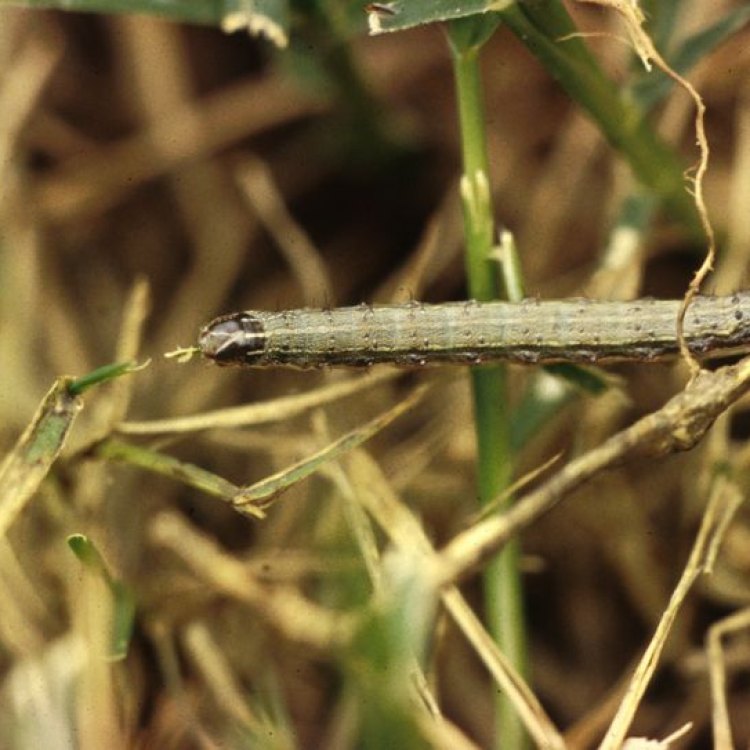
Armyworm
- Adult Size: Small to medium-sized
- Average Lifespan: Approximately 2 to 3 months
- Reproduction: Sexual
- Reproductive Behavior: Mating occurs at night
- Sound or Call: No sound or call
- Migration Pattern: Migratory, adults can travel long distances
- Social Groups: No social groups
- Behavior: Active at night (nocturnal)
- Threats: Pesticides, parasitoids, predators
- Conservation Status: Not evaluated
- Impact on Ecosystem: Can cause significant damage to crops
- Human Use: None
- Distinctive Features: Striped body pattern
- Interesting Facts: Can form large swarms and rapidly defoliate crops
- Predator: Birds, bats, spiders, and parasitoid wasps
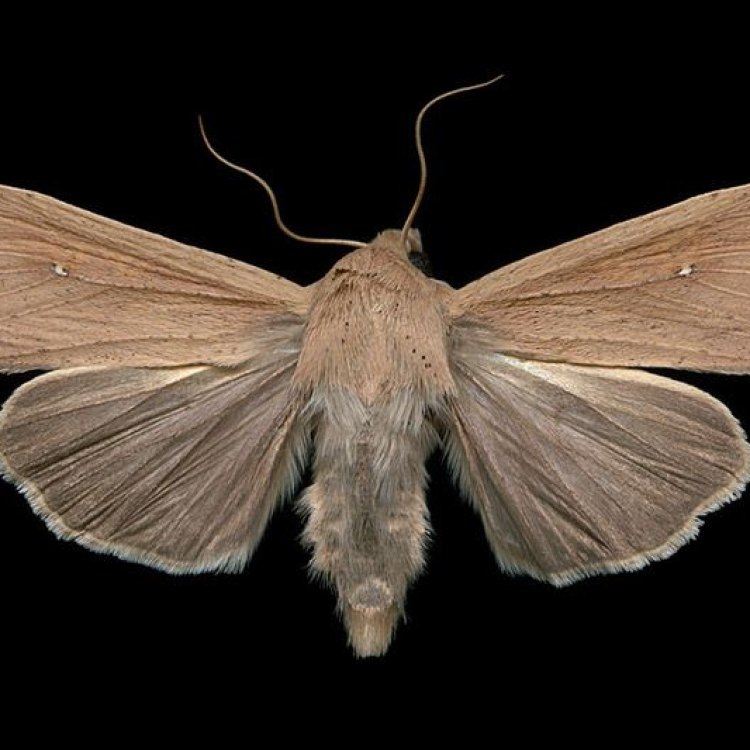
Mythimna unipuncta
The Elusive Armyworm: A Small but Mighty Pest
The armyworm, also known as Spodoptera frugiperda, is a small to medium-sized moth that belongs to the family Noctuidae. This pest is widely distributed across the Americas, Africa, and Asia and is commonly found in crop fields, gardens, and grasslands. Although it may seem small in size, the armyworm has gained notoriety for its destructive feeding habits, making it a serious threat to global agriculture.So what exactly makes this seemingly harmless moth so devastating? Let’s take a closer look at the unique features and behaviors of the armyworm and how it impacts its surrounding ecosystem PeaceOfAnimals.Com.
Adult Size and Average Lifespan
Armyworms typically grow to be small to medium-sized moths, with a wingspan of about 25 to 35 mm. This may seem relatively small, especially compared to other insects like beetles or butterflies, but it is the larvae of these moths that cause the most damage.
The average lifespan of an armyworm is approximately 2 to 3 months, with the adult stage lasting for only 5 to 7 days. This short lifespan is due to their focus on reproduction and the amount of energy they expend during their active feeding stage as larvae.
Reproduction and Mating Behavior
The armyworm reproduces sexually, with males and females engaging in a mating ritual at night. During this time, the male will release pheromones to attract the female, who will then lay her eggs in clusters on the underside of leaves. A single female can lay up to 1000 eggs, and these eggs will hatch within 2 to 4 days.
Once the larvae hatch, they will immediately start feeding on the surrounding vegetation, consuming large amounts of plant matter in a short period. This is their most active stage, and when they are most destructive to crops Asian Elephant.
Sound or Call and Migration Pattern
Unlike other insects, the armyworm does not produce any sound or call. However, they are known for their migratory behavior, which makes them a difficult pest to control. As their name suggests, armyworms have the ability to move in large numbers, similar to an army, and can travel long distances in search of suitable food sources.
They are known to migrate during times of food scarcity or when temperatures become too hot or cold. This means that even if a certain area is free of armyworms, they can quickly reappear due to migration from neighboring regions.
Social Groups and Behavior
The armyworm is a solitary insect and does not form social groups. However, they can be found in large numbers, especially during their larval stage. This is when they form swarms, feeding in unison and causing widespread damage to crops.
Their behavior is primarily nocturnal, meaning they are most active at night. This makes it difficult to detect and control them, as they can quickly infest a field while remaining undetected during the day.
Threats and Conservation Status
The armyworm has various natural enemies that help control its population, such as birds, bats, spiders, and parasitoid wasps. However, their greatest threats come from human activities. Pesticides, which are commonly used in agriculture, can be harmful to armyworms and can also have detrimental effects on other beneficial insects and the surrounding ecosystem.
Additionally, parasitoids, such as wasps, can also help control armyworm populations, but their effectiveness can be reduced when pesticides are used. The impact of pesticides on these natural predators can also have a cascading effect on the ecosystem, leading to imbalances in the food chain.
Despite their destructive nature, the armyworm has not been evaluated for conservation status. This is because they are not a native species to most regions and do not have any significant economic or ecological value.
Impact on the Ecosystem
One of the most significant impacts of armyworms on the ecosystem is their ability to cause significant damage to crops. These pests are general feeders, which means they can feed on a wide variety of plants, including corn, soybean, wheat, and rice. This makes them a threat to agricultural production, especially in countries where subsistence farming is common.
When a large infestation occurs, armyworms can rapidly defoliate crops, resulting in yield losses and economic hardship for farmers. In severe cases, they can even cause complete crop failure, leading to food shortages and price increases.
Human Use and Distinctive Features
Unlike other insects, there is no known use for armyworms by humans. This is mainly due to their destructive nature and the fact that they do not have any valuable by-products.
However, one distinctive feature that sets them apart from other moths is their striped body pattern, which is the origin of their name “army” worm. This pattern helps camouflage them during their feeding stage, making it difficult for predators to detect and consume them.
Interesting Facts About Armyworms
Aside from their destructive impact on crops, armyworms have some interesting and unique characteristics. Here are a few facts that may surprise you about these elusive pests:
- Armyworm larvae have strong mandibles and can consume their body weight in plants every day.
- They are cannibalistic, meaning they will eat other armyworms if no other food sources are available.
- A single armyworm can cause up to 80% yield loss in maize fields.
- The armyworm population can double in size every 4 to 5 days, making it difficult to control their spread.
- They form swarms that can travel up to 300 miles, making them a threat to crops in multiple regions.
Predators of Armyworms
As mentioned earlier, armyworms have natural predators that help control their population. These include birds, bats, spiders, and parasitoid wasps. Birds, such as starlings, and bats feed on the adult moths, while spiders and wasps prey on the larvae.
Additionally, some pathogens, such as bacteria and viruses, can infect armyworms, further reducing their numbers. However, predators alone cannot effectively control armyworm populations, and integrated pest management strategies are necessary to manage their impact on crops.
Conclusion
In conclusion, the armyworm may seem like a small and insignificant pest, but it has proven to be a mighty threat to global agriculture. With its unique features and behaviors, it has the ability to cause significant damage to crops, leading to economic and ecological consequences. As farmers and researchers continue to study and develop ways to manage this pest, we can hope to find more sustainable and effective methods to control their impact and protect our food supply.
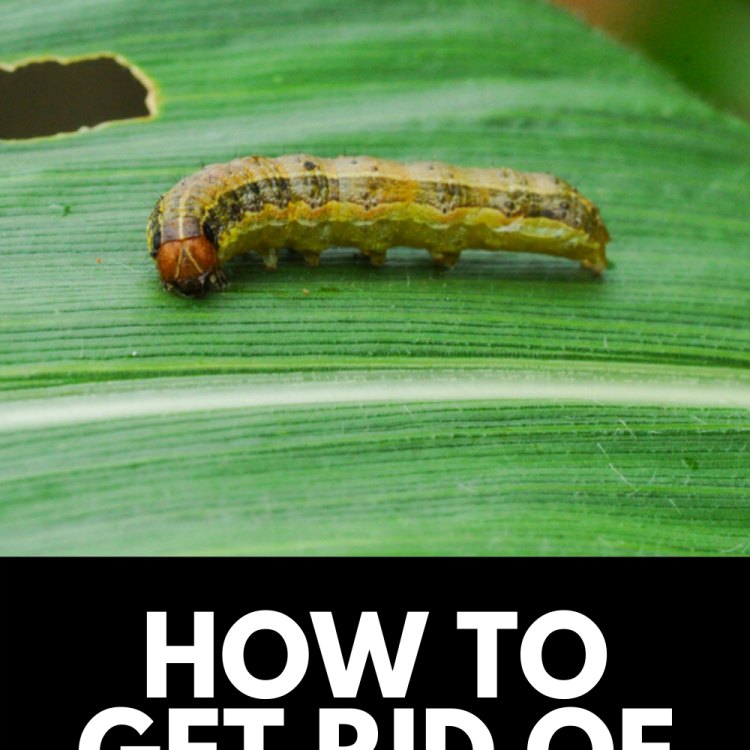
The Fascinating Armyworm: An Insect with a Unique Way of Living
Disclaimer: The content provided is for informational purposes only. We cannot guarantee the accuracy of the information on this page 100%. All information provided here may change without prior notice.

